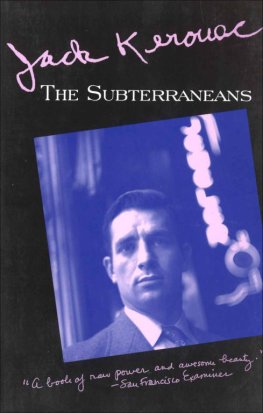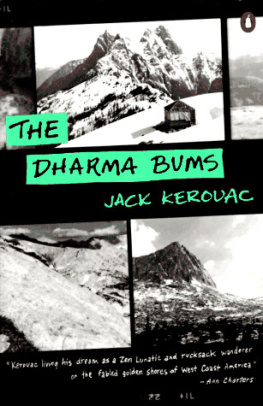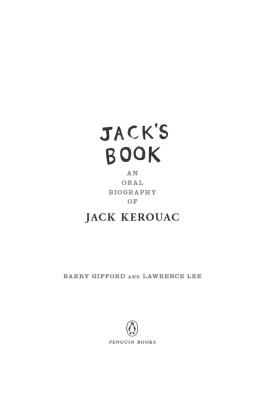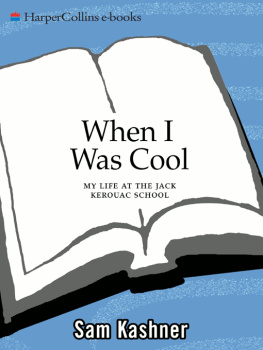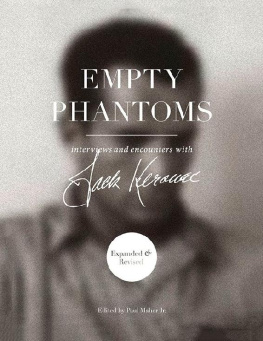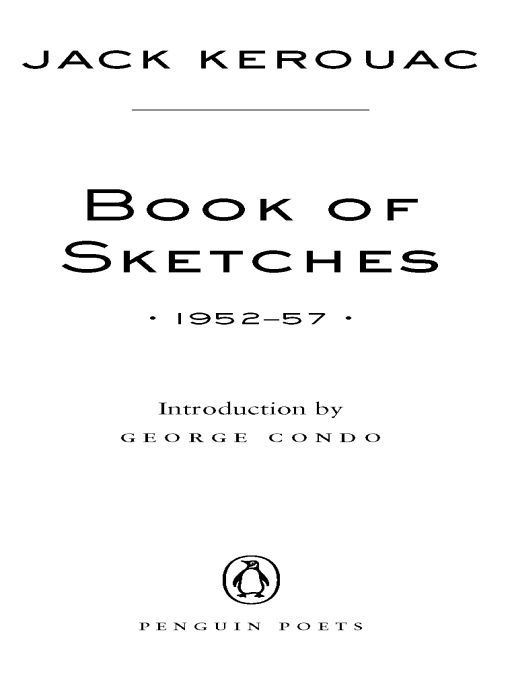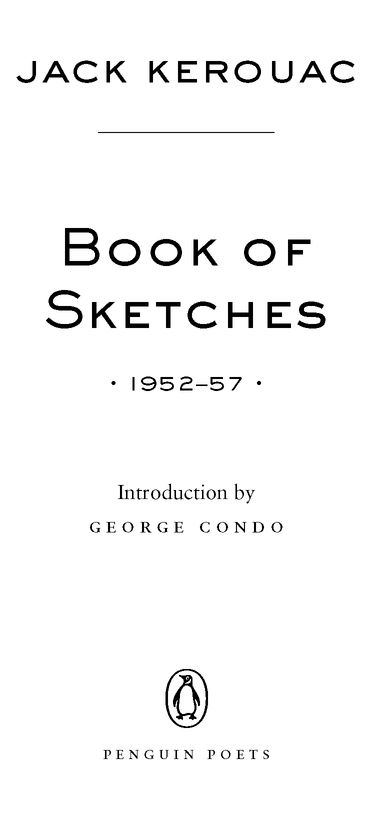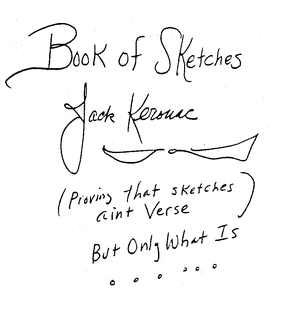Table of Contents
PENGUIN POETS
BOOK OF SKETCHES
JACK KEROUAC was born in Lowell, Massachusetts, in 1922, the youngest of three children in a Franco-American family. He attended local Catholic and public schools and won a scholarship to Columbia University in New York City, where he met Allen Ginsberg and William S. Burroughs. His first novel, The Town and the City, appeared in 1950, but it was On the Road, first published in 1957, that made Kerouac one of the best-known writers of his time. Publication of his many other books followed, among them The Subterraneans, Big Sur, and The Dharma Bums. Kerouacs books of poetry include Mexico City Blues, Scattered Poems, Pomes All Sizes, Heaven and Other Poems, Book of Blues, and Book of Haikus. Kerouac died in St. Petersburg, Florida, in 1969, at the age of forty-seven.
GEORGE CONDO is a painter and sculptor who has exhibited extensively in both the United States and Europe, with works in the collections of the Whitney Museum of American Art, The Museum of Modern Art, New York, and many other institutions. In 1999, Condo received an Academy Award from the American Academy of Arts and Letters and in 2005 he received the Francis J. Greenberger Award. He is represented by Luhring Augustine in New York, Andrea Caratsch Galley in Zurich, and Sprth Magers Lee in London.
ALSO BY JACK KEROUAC
THE DULUOZ LEGEND
Visions of Gerard
Doctor Sax
Maggie Cassidy
Vanity of Duluoz
On the Road
Visions of Cody
The Subterraneans
Tristessa
Lonesome Traveller
Desolation Angels
The Dharma Bums
Book of Dreams
Big Sur
Satori in Paris
POETRY
Mexico City Blues
Scattered Poems
Pomes All Sizes
Heaven and Other Poems
Book of Blues
Book of Haikus
OTHER WORK
The Town and the City
The Scripture of Golden
Eternity
Some of the Dharma
Old Angel Midnight
Good Blonde & Others
Pull My Daisy
Trip Trap
Pic
The Portable Jack Kerouac
Selected Letters: 1940-1956
Selected Letters: 1957-1969
Atop an Underwood
Door Wide Open
Orpheus Emerged
Departed Angels
Windblown World
Beat Generation
Dedicated to the memory of
Caroline Kerouac Blake
INTRODUCTION
Thoughts about Jack Kerouac
Read this Book of Sketches and youll be amazed at what a genius Jack Kerouac was.
These poems just breathe and flow, and when Jack plays the Blues, which he often does, his blues are truly sad they are sadness without humor, without the joking and backslapping that come from good times. They are the real unfunny truth. Like when his older brother Gerard died. This is one of the saddest poems ever written.
I learned a lot from Jack, and I can say all this not being a writer. At the age of fourteen he was the first radical I ever heard of. When I first became aware that he wrote his novel The Subterraneans in one long stretch, unrevised straight out of his head in three days, and that he had a steel trap memory it was the combination of these two very important factors that inspired a new way of painting for me. From then on I combined memory, speed, and spontaneity to create most of my work. I relied on the Kerouacian notion of the unrevised method of creation, and it became the key to a pure uncontrollable mastery of chaos.
As a reader, you would think Kerouac was talking, not writing. Yet it was precisely everyday speech that he was able to conjure up. He, like Jackson Pollock, found a way to take something all of us see and use every day and turn it into Art. This new language of Jack Kerouac was the one we had always been speaking. You just had to know what you were talking about before you spoke.
Jacks concept of writing was also very art-inspired he drew on Andr Massons Automatic Painting and Charlie Parkers informed improvisations to carve out his unique style and destination. He called upon Leonardo da Vincis method of observation in his studies of flowers, storms, anatomy, and physiognomy. Jack is to literature what Charlie Parker was to music or Jackson Pollock was to painting. Its that simple. Proust should be invoked here, too. He must have been one of Kerouacs favorite writers because he used him to describe Miles Daviss phrasing in order to enhance a cultural value that had not yet been perceived he spoke of Miless playing eloquent phrases, just like Marcel Proust.
To look at Edward Hoppers paintings of the late 1920s and early 1930s is to see the destitute ambience of New York City and its existential paradox it is a place at once industrious and at the same time empty, lonely, and unanswered. These qualities are found in some of Kerouacs poetical sketches gas stations, old barges, oil tankers, silhouettes of a positive industry set against dark empty exteriors that have been forgotten and misplaced: Indian land or an old gold mine, towns at one time prosperous now distinctly gone, reflecting an America that no one wanted to admit was still there.
Jack himself had a cubist take on Hopper not unlike Joseph Stellas faceted Brooklyn Bridge cubist in the sense that the fragmentation is not of imagery but of time and space. The elements of chronology in these sketches are here of no importance. In fact, Jack has made a note, Not Necessarily Chronological, this being on his mind in a larger sense referring to all the poems in the Book of Sketches, but also referring to the sequence of words within each poem. Thats what gives a sketch its edge, the fractured, almost cut-up feel that the descriptions carry. They seem to be running straight at you and then split up unexpectedly into multiple directions simultaneously, ending on a resolved note somehow related and yet striking out in a new direction.
Unlike Hopper, though, Kerouac did not long for the past he did not reminisce for the sake of nostalgia or transpose the European masters sensibility. Rather, in the 1950s he broke free and prophetically dreamed a future world of young people wearing Levis and being cut loose from all the crumbling conventions. Jack saw into the future, he lived in the future. That is exactly what happened in the 1960s to society, but by then Jack was too old and self-abused to have any pleasure from the world he predicted.
As the sketches tell us, anything that Jack saw was important. Anything that caught his eye and that he wrote about became priceless. Because in the way that an artist like Picasso could see with his brush, Jack could see with his pen. He was able to capture the spirit of his time without making anything up. And as it came to us from nowhere it certainly was astounding how concrete it all is now. It is as if the only true picture of humanity we will ever have was given to us by Jack Kerouac. All else is false and dressed up. Only Jack and Vincent van Gogh told the inner truth.
George Condo, November 2005
BOOK OF SKETCHES
JACK KEROUAC


